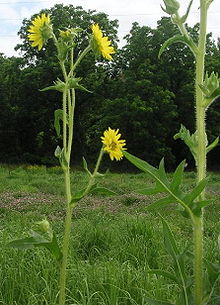- Silphium laciniatum
-
Silphium laciniatum 
Conservation status Scientific classification Kingdom: Plantae (unranked): Angiosperms (unranked): Eudicots (unranked): Asterids Order: Asterales Family: Asteraceae Tribe: Heliantheae Genus: Silphium Species: S. laciniatum Binomial name Silphium laciniatum
L.Silphium laciniatum (Compass Flower, Compass Plant or Rosinweed) is a species of flowering plant in the genus Silphium. It is native to east-central North America, from southern Ontario and New York south to Alabama and west across the prairies to North Dakota and Colorado south to Texas.
Contents
Growth
It is a perennial herbaceous plant similar in appearance to a sunflower, growing to 1-4 m tall, with bristly-hairy stems. The leaves are alternately arranged, and deeply pinnately lobed; the basal leaves up to 40 cm long, becoming smaller higher up the stem. The flowers are produced in flowerheads (capitula) 5-12 cm diameter, with a ring of ray florets surrounding the 2-3 cm diameter center of disc florets. Flowering is in late summer, typically from July to September.
Characteristics
Compass plants are so named because they tend to align their foliage North - South to present the minimum surface area to the hot noon sunshine. The taproot of the compass plant may grow to more than 9-14 ft. deep, making it hardy and resistant to drought.
Medicinal uses
The plant was used in Native American herbal medicine as a vermifuge, and to treat coughs and asthma.Cultural
Cultural allusions
Aldo Leopold devotes much of the July entry in _A Sand County Almanac_ to Silphium -- its hardiness, but its slow disappearance nevertheless. "It is easy now to predict the future. For a few years my Silphium will try in vain to rise above the mowing machine, and then it will die. With it will die the prairie epoch.”
References
- ^ "Silphium laciniatum". NatureServe Explorer. NatureServe. http://www.natureserve.org/explorer/servlet/NatureServe?searchName=Silphium+laciniatum+. Retrieved 2007-07-04.
- Blanchan, Neltje (2002). Wild Flowers: An Aid to Knowledge of our Wild Flowers and their Insect Visitors. Project Gutenberg Literary Archive Foundation.
- Flora of North America: profile and map: Silphium laciniatum
- Germplasm Resources Information Network: Silphium laciniatum
- "Silphium laciniatum". Integrated Taxonomic Information System. http://www.itis.gov/servlet/SingleRpt/SingleRpt?search_topic=TSN&search_value=38401.
- Missouriplants: Silphium laciniatum
- Plants for a Future: Silphium laciniatum
- USDA Plant Profile: Silphium laciniatum
- Weaver, J.E. 1958. Classification of Root Systems of Forbs of Grassland and a Consideration of Their Significance. Ecology, Vol. 39, No. 3. pp. 394-401.

This Heliantheae article is a stub. You can help Wikipedia by expanding it.

